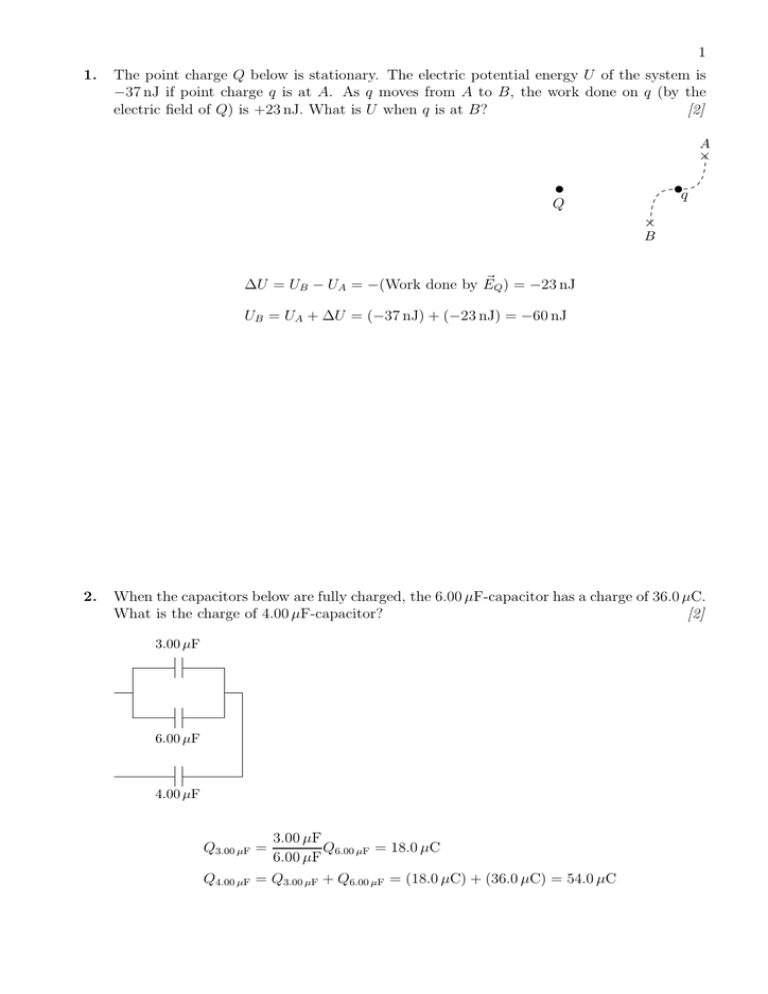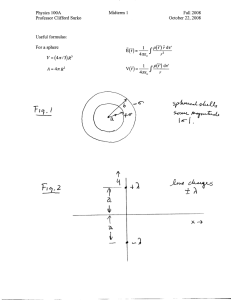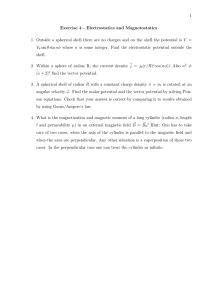1 1. The point charge Q below is stationary. The electric potential
advertisement

1 1. The point charge Q below is stationary. The electric potential energy U of the system is −37 nJ if point charge q is at A. As q moves from A to B, the work done on q (by the electric field of Q) is +23 nJ. What is U when q is at B? [2] A × q Q × B ~ Q ) = −23 nJ ∆U = UB − UA = −(Work done by E UB = UA + ∆U = (−37 nJ) + (−23 nJ) = −60 nJ 2. When the capacitors below are fully charged, the 6.00 µF-capacitor has a charge of 36.0 µC. What is the charge of 4.00 µF-capacitor? [2] 3.00 µF 6.00 µF 4.00 µF Q3.00 µF = 3.00 µF Q6.00 µF = 18.0 µC 6.00 µF Q4.00 µF = Q3.00 µF + Q6.00 µF = (18.0 µC) + (36.0 µC) = 54.0 µC 2 3. In the diagram below, q = 0.10 nC and d = 3.0 cm. Find the x-component Ex of the net electric field at the point with coordinates (−4.0 cm, +4.0 cm). [4] r+q = √ r−q = √ cos θ+q 17.0 cm ~ +q E y 65.0 cm ~ −q × E 1.0 =√ 17.0 7.0 cos θ−q = √ 65.0 θ+q +q θ−q d d −q x ~ +q | cos θ+q + |E ~ −q | cos θ−q Ex = −|E = −8.2 N/C 4. A point charge q = 2.40 nC is at the center of a spherical conducting shell (inner radius of 1.00 cm, outer radius of 1.20 cm). The electric field 4.00 cm from the center of the shell has a magnitude of 5.00 kV/m and points radially inward. Find the surface charge density on the outer surface of the shell. (Justify your choice of sign.) [3] q ~ = 8.89 × 10−10 C |Qoutside | = 4πǫ0 (4.00 cm)2 |E| |σ| = |Qoutside | = 4.91 × 10−7 C/m2 4π(1.20 cm)2 ~ inward σ<0: E 3 5. Three long straight parallel wires (seen end-on below) carry currents out of the page; ~ at A. a = 2.50 cm. Find the magnitude of the net magnetic field B [3] ~ 7.0 A B 7.0 A 1.0 A 4a A 3a ~ 1.0 A B 4.0 A 2a ~ 4.0 A B ~ = |B ~ 4.0 A | − |B ~ 7.0 A | − |B ~ 1.0 A | |B| µ0 4.0 7.0 1.0 = − − 2π 2a 7a 3a = 5.3 × 10−6 T 6. Find the rate at which energy is being gained by the capacitor below when the plate charge is Q = 30.0 µC. [3] 12.0 V 3.00 kΩ 10.0 µF I Q = E− R = 3.0 × 10−3 mA C dU = EI − I 2 R dt = 9.0 × 10−3 W 4 7. In the coaxial cable shown in cross-section below, the central cylindrical conductor (radius a) and the outer coaxial conducting tube (inner radius b, outer radius c) carry equal currents I = 12.0 A in opposite directions. The current densities are uniform; a = 1.5 mm, b = 3.0 mm and c = 4.5 mm. Find the magnitude of the magnetic field 4.0 mm from the central axis. [4] Using amperian loop C, h i ~ = µ0 I − (Itube inside C) |B| 2πr C r a Jtube = I (out) π(c2 I = 3.4 × 105 A/m2 − b2 ) Itube inside C = Jtube π(r 2 − b2 ) = 7.5 A I (in) ~ = 2.3 × 10−4 T |B| 8. A very long insulating cylinder (of radius 4.00 cm) has a uniform charge on its outer surface; the surface charge density is −35.0 µC/m2 . Find the potential difference VA − VB , where A is a point on the outer surface and B is a point 12.0 cm from the central axis. [4] VA − VB = + 12 Z cm 2kλ dr r 4 cm = 2kλ ln 3 λ = 2π(4.00 cm)σ = −8.80 × 10−6 C/m VA − VB = −1.7 × 105 V 5 9. Find the voltage Va − Vc in the circuit below. 1.6 Ω 16.0 V a [3] b 13.4 Ω 1.0 Ω 12.0 V c d Loop rule (I counter-clockwise): 16.0 V − I(1.6 Ω) − I(1.0 Ω) − 12.0 V − I(13.4 Ω) = 0 =⇒ I = 0.25 A Va − Vc = 12.0 V + I(1.0 Ω) = 12.25 V ~ 1 and B ~ 2 perpendicular 10. The grey rectangles below are regions of uniform magnetic field B ~ to the plane of the page; |B2 | = 1.5 T. The path of an electron of constant speed v is shown; ~ 1. R2 = 2.5R1 . Find the direction and magnitude of B [3] B~2 R2 ~ 1| R2 |B = ~ 2| R1 |B ~ 1| = |B B~1 R1 R2 ~ |B2 | = 3.75 T R1 ~ 1 out of the page B e− 6 1. A positive point charge q is placed at the centre of a conducting shperical shell. The electric field lines are as shown in the figure. If Q is the net charge on the shell, then (a) Q < 0, with |Q| > q . (b) Q < 0, with |Q| < q. (c) Q < 0, with |Q| = q. (d) Q = 0. q 2. An electron with initial velocity along the positive x-direction passes straight through a region of uniform electric and magnetic fields. The electric field is in the negative y-direction. So, the magnetic field must be such that, (a) By = 0, and Bz > 0. (b) By = 0, and Bz < 0 . (c) By > 0, and Bz < 0. (d) By < 0, and Bz = 0. r a (a) V(r) V(r) V(r) V(r) 3. A conducting sphere of radius a has a positive charge. Which one of the following figures best represents the variation of electric potential V (r) as a function of distance r from the centre of the sphere? (V (r) is taken to be zero at r → ∞). r a (b) r a r (c) a (d) Ans: c 4. Two point charges, q1 and q2 , initially a distance d apart are released from rest. They will move in such a way that their potential energy (a) always increases as they move. (b) always decreases as they move . (c) increases if they have same sign and decreases if they have opposite signs. (d) decreases if they have same sign and increases if they have opposite signs. 5. A point charge is placed at the centre of the top face of the cubical surface shown in the figure. If Φ0 is the electric flux through the bottom face of the cube, the electric flux through the shaded face of the cube is (a) Φ0 . q (b) ε0 − Φ0 . q (c) 15 2ε − Φ0 . 0 q (d) 14 2ε − Φ0 . 0 q 111 000 000 111 7 6. A parallel-plate capacitor is connected to a battery. Let E and Q be the magnitudes of the electric field between the plates and the plate-charge respectively. If the plate-separation is increased while it is still connected to a battery, (a) E will increase, but Q will decrease. (b) E will decrease, but Q will increase. (c) both E and Q will decrease . (d) E will remain the same but Q will decrease. 7. In the four different circuits shown, all the resistors are identical as well as the sources of emf. In which circuit is the power dissipated by the resistor R1 greatest? R1 R1 ε R2 R2 ε ε R2 ε R1 R3 R1 R2 R3 R3 R3 (a) (b) (c) (d) 8. In the figure shown, the two long parallel wires carrying currents are perpendicular to the plane of paper. The net magnetic field at the point P is in the negative y-direction. Then Y (a) I1 is out of the plane and I2 is into the plane. P (b) I1 is out of the plane and I2 is out of the plane. (c) I1 is into the plane and I2 is out of the plane . B (d) I1 is into the plane and I2 is into the plane. I1 I2 9. In the circuit shown, all the resistors are identical. What is the charge on the capacitor when the steady state has reached? (a) Q = CE. (b) Q = CE/2 . (c) Q = CE/3. (d) Q = CE/4. R ε R R C R 10. Two long identical solenoids have lengths that are very large compared to their diameters. They carry equal currents in the same direction. Let B be the magnitude of the magnetic field inside each of the solenoids. If they are joined together at one end, the magnitude of the magnetic field inside them will be (a) 2B. (b) B . (c) B/2. (d) zero. X





